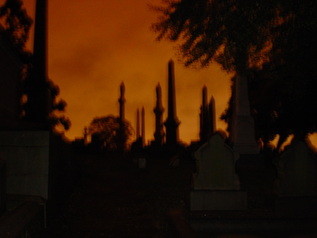
Smith’s very personal experience ultimately had very public implications, as less than one year later, this grieving father founded Laurel Hill Cemetery with partners Nathan Dunn, Benjamin W. Richards and Frederick Brown. When Smith conceived of Laurel Hill, he envisioned something fundamentally different from the burial places that came before it, and the site has continued to hold an important place of distinction as one of the first cemeteries of its kind. Key concepts to Laurel Hill’s founding were that it had to be situated in a picturesque location well outside the city; that it had no religious affiliation; and that it provided a permanent burial space for the dead in a restful and tranquil setting.
In an era when the city suffered from crowding, disease and scarcity of public space, Laurel Hill offered an “alternative environment.” Previously, churchyards were the only places available to bury the dead, and they were often as crowded and unsanitary as the streets that bordered them. Worse yet, rapid industrialization and population growth commonly led to the disinterment of burial grounds to make way for roads and buildings. Laurel Hill’s founding is deeply rooted in the cultural history of Philadelphia’s urbanization, and in the simultaneous development of crafted, suburban sanctuaries of nature and retreat just beyond the city’s limits. Laurel Hill was not only established as a permanent, non-sectarian burial place for the dead, but also as a scenic, riverside sanctuary for the living.
Selecting an appropriate site was one of the first challenges facing the cemetery's founders. Several options fell through before a group of proprietors, led by Smith, were able to purchase a former estate known as Laurel Hill in 1836. From 1797 to 1824, the 32-acre property located north of the city overlooking the Schuylkill River had been the county seat of merchant Joseph Simms. The estate was later used as a farm, a tavern and a boarding school. Laurel Hill’s proximity to the River was perhaps the site’s most important selling point for its founders, in an effort to establish the Cemetery as “a place apart.” Following an afternoon leisure trip to Laurel Hill in 1838, one early Philadelphian noted in his diary, “Wandered about the cemetery for half an hour, looking at monuments & gravestones…and gazing at the beautiful view up and down the river.” Views of the Schuylkill River have always been an important component of the site’s visual character, and a central part of the Laurel Hill Cemetery experience for visitors of past and present.
After the land purchase, an informal competition was held to choose a designer for Laurel Hill, through which Scottish architect John Notman was selected. Notman conceived of the Cemetery as an estate garden, based in part on English ideas of planned landscapes as transitions between art and nature. Key features of Notman's design for Laurel Hill were a three-tiered circulation system with the main carriage loop, secondary roads, and paths all converging near the center. Notman also added a Doric Roman Gatehouse, a superintendent's house and a chapel. Notman designed the Cemetery to take advantage of the river, and his plan was ultimately chosen over those of his counterparts because it carved out the landscape into an amphitheatre-like formation that offered great river views. Many early visitors and funeral-goers traveled to Laurel Hill via steamboat, once the vehicles started plying the Schuylkill River on a regular basis in the 1840s. Steamboats Washington, Mount Vernon and Frederick Graff embarked hourly on a circuit between Fairmount and the Falls of Schuylkill, emptying a stream of lot-holders and sightseers at Laurel Hill.
Since the earliest days of Laurel Hill, the founders and managers of the Cemetery recognized the great potential for recreation that the rural, picturesque site held. Laurel Hill preceded New York’s Central Park by more than two decades, and was most certainly an inspiration for Philadelphia’s Fairmount Park. Picnics, strolls, carriage rides and sightseeing were popular pastimes in Laurel Hill’s early days, when “nearly 30,000 persons…entered the gates between April and December, 1848.” The site continues to remain a favored retreat for tourists, joggers, bicyclists, nature lovers, sketch artists and amateur photographers.
Today, Laurel Hill is located in the North section of Philadelphia, comprising an estimated 78-acre tract of land that is divided into three sections—the North, Central and South portions of the Cemetery—that were each founded at different times in the site’s development. Every expansion continues to remain clearly etched upon the Cemetery’s landscape. Laurel Hill is one of the few cemeteries in the nation to be honored with the designation of National Historic Landmark, a title received in 1998. Numerous prominent people are buried at the Cemetery, including many of Philadelphia’s leading industrial magnates. Names such as Rittenhouse, Widener, Elkins and Strawbridge certainly pique local interests, but Laurel Hill also appeals to a national audience. General Meade and thirty-nine other Civil War-era generals reside here, in addition to six Titanic passengers. As in its earliest days, Laurel Hill’s natural beauty and serenity continue to render it a bucolic retreat nestled within the city’s limits overlooking the Schuylkill River. This beautiful green space is further complemented by the breathtaking art, sculpture and architecture that can be found here. These are just some of the many attributes that render Laurel Hill Cemetery a primary destination for local and national visitors to the City of Brotherly Love.
**Taken from www.thelaurelhillcemetery.org**


 RSS Feed
RSS Feed